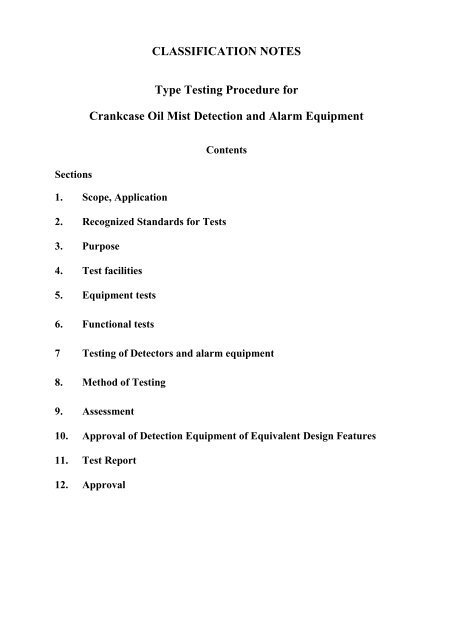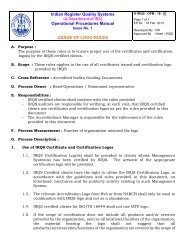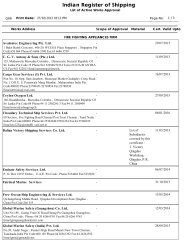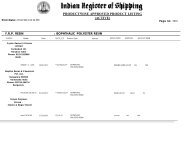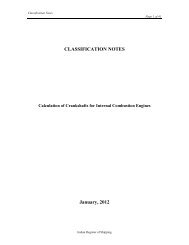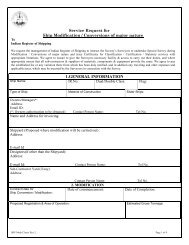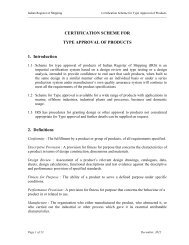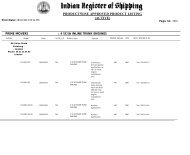PDF file - Indian Register of Shipping
PDF file - Indian Register of Shipping
PDF file - Indian Register of Shipping
- No tags were found...
You also want an ePaper? Increase the reach of your titles
YUMPU automatically turns print PDFs into web optimized ePapers that Google loves.
CLASSIFICATION NOTESType Testing Procedure forCrankcase Oil Mist Detection and Alarm EquipmentContentsSections1. Scope, Application2. Recognized Standards for Tests3. Purpose4. Test facilities5. Equipment tests6. Functional tests7 Testing <strong>of</strong> Detectors and alarm equipment8. Method <strong>of</strong> Testing9. Assessment10. Approval <strong>of</strong> Detection Equipment <strong>of</strong> Equivalent Design Features11. Test Report12. Approval
Page 2 <strong>of</strong> 14Type Testing Procedure for Crankcase Oil Mist Detection and Alarm Equipment<strong>Indian</strong> <strong>Register</strong> <strong>of</strong> <strong>Shipping</strong>
Page 3 <strong>of</strong> 14Type Testing Procedure for Crankcase Oil Mist Detection and Alarm EquipmentType Testing Procedure forCrankcase Oil Mist Detection and Alarm Equipment1. Scope, Application1.1 This type testing procedure specifies tests required to demonstrate that crankcase oilmist detection and alarm equipment intended to be fitted to diesel engines satisfy IRSrequirements.1.2 This test procedure is also applicable to oil mist detection and alarm equipmentintended for gear cases.1.3 Engines are to be fitted with crankcase oil mist detection and alarm equipmentcomplying with this Classification Notes when:a) An application for certification <strong>of</strong> an engine is dated on/after 1 January 2007; orb) Installed in new ships for which the date <strong>of</strong> contract for construction is on or after1 January 2007.The requirements in para 6.7 and 6.8 are applicable from 01 January 2008.<strong>Indian</strong> <strong>Register</strong> <strong>of</strong> <strong>Shipping</strong>
Page 5 <strong>of</strong> 14Type Testing Procedure for Crankcase Oil Mist Detection and Alarm Equipment3. Purpose3.1 The purpose <strong>of</strong> type testing crankcase oil mist detection and alarm equipment is toverify:3.1.1 The functionality <strong>of</strong> the system.3.1.2 The effectiveness <strong>of</strong> the oil mist detectors.3.1.3 The accuracy <strong>of</strong> oil mist detectors.3.1.4 The alarm set points.3.1.5 Time delays between occurrence <strong>of</strong> oil mist at the source and activation <strong>of</strong> alarm.3.1.6 Functional failure detection.3.1.7 The influence <strong>of</strong> optical obscuration on detection.<strong>Indian</strong> <strong>Register</strong> <strong>of</strong> <strong>Shipping</strong>
Page 6 <strong>of</strong> 14Type Testing Procedure for Crankcase Oil Mist Detection and Alarm Equipment4. Test facilities4.1 Test houses carrying out type testing <strong>of</strong> crankcase oil mist detection and alarmequipment are to satisfy the following criteria:4.1.1 A full range <strong>of</strong> facilities for carrying out the environmental and functionality testsrequired b y this procedure are to be available and be acceptable to IRS.4.1.2 The test house is to be equipped so that it can control, measure and record oil mistconcentration levels in terms <strong>of</strong> mg/l to an accuracy <strong>of</strong> 10% in accordance with thisprocedure.<strong>Indian</strong> <strong>Register</strong> <strong>of</strong> <strong>Shipping</strong>
Page 7 <strong>of</strong> 14Type Testing Procedure for Crankcase Oil Mist Detection and Alarm Equipment5. Equipment tests5.1 The range <strong>of</strong> tests is to include the following:5.1.1 For the alarm/monitoring panel:a) Functional tests described in Section 6.b) Electrical power supply failure test.c) Power supply variation test.d) Dry heat test.e) Damp heat test.f) Vibration testg) EMC testh) Insulation resistance test.i) High voltage test.j) Static and dynamic inclinations, if oil mist detection equipment has any movingparts.5.1.2 For the detectors:a) Functional tests described in Section 6.b) Electrical power supply failure testc) Power supply variation testd) Dry heat teste) Damp heat test.f) Vibration test.g) EMC test where susceptible.h) Insulation resistance test.i) High voltage test.j) Static and dynamic inclinations.<strong>Indian</strong> <strong>Register</strong> <strong>of</strong> <strong>Shipping</strong>
Page 8 <strong>of</strong> 14Type Testing Procedure for Crankcase Oil Mist Detection and Alarm Equipment6. Functional tests6.1 All tests required to verify the functionality <strong>of</strong> crankcase oil mist detection and alarmequipment are to be carried out in accordance with 6.2 to 6.6 with an oil mistconcentration in air, known in terms <strong>of</strong> mg/ltr to an accuracy <strong>of</strong> + 10%.6.2 The concentration <strong>of</strong> oil mist in the test chamber is to be measured in the top andbottom <strong>of</strong> the chamber and these concentrations are not to differ by more than 10%.See also 8.1.1.1.6.3 The oil mist monitoring arrangements are to be capable <strong>of</strong> detecting oil mist in airconcentrations <strong>of</strong> between 0 and 10% <strong>of</strong> the lower explosive limit (LEL) or between 0and a percentage corresponding to a level not less than twice the maximum oil mistconcentration alarm set point.Note: The LEL corresponds to an oil mist concentration <strong>of</strong> approximately 50mg/l(~4.1% weight <strong>of</strong> oil in air mixture).6.4 The alarm set point for oil mist concentration in air is to initiate an alarm at amaximum level corresponding to not more than 5% <strong>of</strong> the LEL or approximately2.5mg/16.5 Where alarm set points can be altered, the means <strong>of</strong> adjustment and indication <strong>of</strong> setpoints are to be verified against the equipment manufacturer's instructions6.6 Where oil mist is drawn into a detector via piping arrangements, the time delaybetween the sample leaving the crankcase and operation <strong>of</strong> the alarm is to bedetermined for the longest and shortest lengths <strong>of</strong> pipes recommended by themanufacturer. The piping arrangements are to be in accordance with themanufacturer's instructions/recommendations.6.7 Detector equipment that is in contact with the crankcase atmosphere and may beexposed to oil splash and spray from engine lubricating oil is to be demonstrated to besuch, that openings do not occlude or get blocked under continuous oil splash andspray conditions. Testing is to be in accordance with arrangements proposed by themanufacturer and agreed by IRS.6.8 Detector equipment may be exposed to water vapour from the crankcase atmospherewhich may affect the sensitivity <strong>of</strong> the equipment and it is to be demonstrated thatexposure to such conditions will not affect the functional operation <strong>of</strong> the detectorequipment. Where exposure to water vapour and/or water condensation has beenidentified as a possible source <strong>of</strong> equipment malfunctioning, testing is to demonstratethat any mitigating arrangements such as heating are effective. Testing is to be inaccordance with arrangements proposed by the manufacturer and agreed by IRS.Note : This testing is in addition to that required by 5.1.2(e) and is to ensure that thecondensation caused by the detection equipment being at a lower temperature than thecrankcase atmosphere does not affect the functioning <strong>of</strong> the equipment.<strong>Indian</strong> <strong>Register</strong> <strong>of</strong> <strong>Shipping</strong>
Page 9 <strong>of</strong> 14Type Testing Procedure for Crankcase Oil Mist Detection and Alarm Equipment7 Testing <strong>of</strong> Detectors and alarm equipment7.1 The detectors and alarm equipment undergoing the type testing are to be selectedfrom the manufacturer’s normal production line by the Surveyor witnessing the tests.7.2 Two detectors are to be tested. One is to be tested in clean condition and the other in acondition representing the maximum level <strong>of</strong> lens obscuration specified by themanufacturer.<strong>Indian</strong> <strong>Register</strong> <strong>of</strong> <strong>Shipping</strong>
Page 10 <strong>of</strong> 14Type Testing Procedure for Crankcase Oil Mist Detection and Alarm Equipment8. Method <strong>of</strong> Testing8.1 The following requirements are to be complied with during type testing:8.1.1 Oil mist generation is to satisfy requirements given in 8.1.1.1 to 8.1.1.5.8.1.1.1 Oil mist is to be generated with suitable equipment using an SAE 80 monogrademineral oil or equivalent and supplied to a test chamber having a volume <strong>of</strong> not less than 1m 3 .The oil mist produced is to have a maximum droplet size <strong>of</strong> 5 m.Note : The oil droplet size is to be checked using the sedimentation method or equivalent.8.1.1.2 The oil mist concentrations used are to be ascertained by the gravimetric deterministicmethod or equivalent.Note : For this test, the gravimetric deterministic method is a process where the difference inweight <strong>of</strong> a 0.8 m pore size membrane filter is ascertained from weighing the filter beforeand after drawing 1 litre <strong>of</strong> oil mist through the filter from the oil mist test chamber. The oilmist chamber is to be fitted with a recirculating fan.8.1.1.3 Samples <strong>of</strong> oil mist are to be taken at regular intervals and the results plotted againstthe oil mist detector output. The oil mist detector is to be located adjacent to where the oilmist samples are drawn <strong>of</strong>f.8.1.1.4 The results <strong>of</strong> a gravimetric analysis are considered invalid and are to be rejected ifthe resultant calibration curve has an increasing gradient with respect to the oil mist detectionreading. This situation occurs when insufficient time has been allowed for the oil mist tobecome homogeneous. Single results that are more than 10% below the calibration curve areto be rejected. This situation occurs when the integrity <strong>of</strong> the filter unit has beencompromised and not all <strong>of</strong> the oil is collected on the filter paper.8.1.1.5 The filters are to be weighed to a precision <strong>of</strong> 0.1 mg and the volume <strong>of</strong> air/oil mistsampled to 10 ml.8.1.2 The testing is to be witnessed by Surveyor.8.1.3 Oil mist detection equipment is to be tested in the orientation (vertical, horizontal orinclined) in which it is intended to be installed on an engine or gear case as specified by theequipment manufacturer.8.1.4 Type testing is to be carried out for each type <strong>of</strong> oil mist detection and alarm equipmentfor which a manufacturer seeks IRS approval. Where sensitivity levels can be adjusted,testing is to be carried out at the extreme and mid-point level settings.<strong>Indian</strong> <strong>Register</strong> <strong>of</strong> <strong>Shipping</strong>
Page 12 <strong>of</strong> 14Type Testing Procedure for Crankcase Oil Mist Detection and Alarm Equipment10. Approval <strong>of</strong> Detection Equipment <strong>of</strong> Equivalent Design Features10.1 The approval <strong>of</strong> one type <strong>of</strong> detection equipment may be used to approve otherdevices having identical construction details. Proposals are to be submitted forconsideration.<strong>Indian</strong> <strong>Register</strong> <strong>of</strong> <strong>Shipping</strong>
Page 13 <strong>of</strong> 14Type Testing Procedure for Crankcase Oil Mist Detection and Alarm Equipment11. Test Report11.1 The test laboratory is to provide a full report consisting <strong>of</strong> following information andany other relevant documents in support <strong>of</strong> the test report:11.1.1 Test specification.11.1.2 Details <strong>of</strong> devices tested.11.1.3 Results <strong>of</strong> tests.<strong>Indian</strong> <strong>Register</strong> <strong>of</strong> <strong>Shipping</strong>


